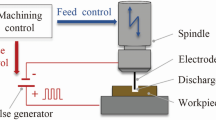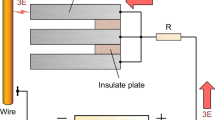Abstract
Conventional electrical discharge machining (EDM) usually took a large gap distance to obtain the integrity of machined surface. However, large gap distances really prevented further improving surface quality and lowered machining efficiency as well. Conversely, this paper took small gap distances in discharging so that discharging from multi-discharging channels could be synchronously realized. To this end, a new adaptive control system for EDM was studied in this paper where arcing ratio was chosen to be a control index and gap servo voltage was a control variable. Arcing ratio was forced to follow a predetermined arcing ratio expectation by adapting gap servo voltage so that arcing pulses could not take place in machining and thus the integrity of the machined surface can be obtained. Compared with conventional EDM, in addition to the more integrated machined surface had been obtained, the surface roughness had been lowered almost 3.5 times and the machining rate improved 2.5 times. Additionally, different forms of multi-discharging channels from one pulse were able to be realized by setting different arcing ratio expectations meeting different requirements of surface roughness. The significance of the study is that forming multi-discharging channels from one pulse displayed an innovative approach in precision EDM.
Similar content being viewed by others
References
Yongfeng LIU, Pucheng PEI (2006) Asymptotic analysis on autoignition and explosion limits of hydrogen-oxygen mixtures in homogeneous systems. Int J Hydrog Energy 31(5):639–647
Luo YF (1997) The dependence of interspace discharge transitivity upon the gap debris in precision electrodischarge machining. J Mater Process Technol 68(68):121–131
Izquierdo B, Sánchez JA, Plaza S, Pombo I, Ortega N (2009) A numerical model of the EDM process considering the effect of multiple discharges. Int J Mach Tool Manu 49(3–4):220–229
Torres A, Luis CJ, Puertas I (2017) EDM machinability and surface roughness analysis of TiB2 using copper electrodes. J Alloys Compd 690:337–347
Torres A, Puertas I, Luis CJ (2015) Modelling of surface finish, electrode wear and material removal rate in electrical discharge machining of hard-to-machine alloys. Precis Eng 40:33–45
Torres A, Puertas I, Luis CJ (2017) Spacing roughness parameters analysis on the EDM of Inconel ® 600 alloy. Proc Manuf 13:573–578
Oßwald K, Schneider S, Hensgen L, Klink A, Klocke F (2017) Experimental investigation of energy distribution in continuous sinking EDM. CIRP J Manuf Sci Technol 19:36–42
Patel KM, Pandey PM, Venkateswara Rao P (2009) Determination of an optimum parametric combination using a surface roughness prediction model for EDM of Al2O3/SiCw/TiC ceramic composite. Int J Adv Manuf Process 24(6):675–682
Pradhan M K, Biswas C K (2009) Modeling and analysis of process parameters on surface roughness in EDM of AISI D2 tool steel by RSM approach. Nova Science Publishers USA, 3:66–71
Das MK, Kumar K, Barman TK, Sahoo P (2014) Application of artificial bee colony algorithm for optimization of MRR and surface roughness in EDM of EN31 tool steel. Procedia Mater Sci 6:741–751
Khan MR, Rahman MM, Kadirgama K (2015) An experimental investigation on surface finish in die-sinking EDM of Ti-5Al-2.5Sn. Int J Adv Manuf Technol 77(9–12):1727–1740
Tomadi SH, Hassan MA, Hamedon Z, Daud R, Khalid AG (2009) Analysis of the influence of EDM parameters on surface quality, material removal rate and electrode wear of tungsten carbide. Lecture Notes Eng Comput Sci 2175(1)
Wang J, Qian J, Ferraris E, Reynaerts D (2016) In-situ monitoring and adaptive control of precision micro-EDM cavity milling. Precis Eng 47:261–275
Khan MAR, Rahman MM, Kadirgama K, Maleque MA, Bakar RA (2011) Artificial intelligence model to predict surface roughness of Ti-15-3 alloy in EDM process. World Academy of Science. Eng Technol 74:121–125
Majumder H, Maity K (2018) Prediction and optimization of surface roughness and micro-hardness using grnn and MOORA-fuzzy-a MCDM approach for nitinol in WEDM. Measurement 118:1–13
Rao PS, Ramji K, Satyanarayana B (2014) Experimental investigation and optimization of wire EDM parameters for surface roughness, MRR and white layer in machining of aluminium alloy. Procedia Mater Sci 5:2197–2206
Shen Y, Liu Y, Zhang Y, Dong H, Sun W, Wang X, Zheng C, Ji R (2015) High-speed dry electrical discharge machining. Int J Mach Tool Manu 93:19–25
Yang S, Chen J, Yang Y, Zhang K, Li Y, Zhu B (2018) Study on the characteristics of plasma channel based on multi-spark pulse discharge machining effect. Int J Adv Manuf Technol
Fonseca J, Marafona JD (2013) The importance of servo reference voltage on multiple discharges. Procedia CIRP 6:416–421
Fua X, Gao L, Zhang Q, Liu Q (2016) Surface roughness research of piezoelectric self-adaptive micro-EDM. Procedia Cirp 42:563–568
Singh G, Singh G, Singh K, Singla A (2017) Experimental studies on material removal rate, tool wear rate and surface properties of machined surface by powder mixed electric discharge machining. Mater Today: Proc 4:1065–1073
Tripathy S, Tripathy DK (2017) Surface characterization and multi-response optimization of EDM process parameters using powder mixed dielectric. Mater Today Proc 4(2):2058–2067
Toshimitsu R, Okada A, Kitada R, Okamoto Y (2016) Improvement in surface characteristics by EDM with chromium powder mixed fluid. Procedia Cirp 42:231–235
Hua FQ, Cao FY, Song BY, Hou PJ, Zhang Y, Chen K, Wei JQ (2013) Surface properties of SiCp/Al composite by powder-mixed. EDM 6:101–106
Antar M, Hayward P, Dunleavey J, Butler-Smith P (2018) Surface integrity evaluation of modified EDM surface structure. Procedia Cirp 68:308–312
Yang F, Bellotti M, Hua H, Yang J, Qian J, Reynaerts D (2018) Experimental analysis of normal spark discharge voltage and current with a RC-type generator in micro-EDM. Int J Adv Manuf Technol 96(5–8):2963–2972
Liu H, Chi G, Wang Z, Wang Y, Li H (2018) Graded layer identification and open voltage adjustment for EDM process of Ni-Al2O3 FGMs. Int J Adv Manuf Technol 99(9–12):2611–2622
Zhou M, Han F, Wang Y, Soichiro I (2009) Assessment of the dynamical properties in EDM process-detecting deterministic nonlinearity of EDM process. Int J Adv Manuf Technol 44:91–99
Zhou M, Xin M, Liang H, Ye Q (2019) Improving EDM performance by adapting gap servo-voltage. J Manuf Process J Manuf Process 37:101–113
L. Ljung (1999) System identification—theory for the user, seconded, Prentice-Hall PTR
K.J. Astrom, B. Wittenmark (1995) Adaptive control, seconded, Addison-Wesley, Reading, MA
Funding
This research project has been financially supported by “The Fundamental Research Funds for Beijing Universities (No.X18082)” and “The Graduate Innovation Project of Beijing University of Civil Engineering and Architecture (No.PG2018083).”
Author information
Authors and Affiliations
Corresponding author
Additional information
Publisher’s note
Springer Nature remains neutral with regard to jurisdictional claims in published maps and institutional affiliations.
Rights and permissions
About this article
Cite this article
Mu, X., Zhou, M. & Ye, Q. Improving surface integrity and surface roughness by forming multi-discharging channels from one pulse in EDM. Int J Adv Manuf Technol 102, 3181–3195 (2019). https://doi.org/10.1007/s00170-019-03373-2
Received:
Accepted:
Published:
Issue Date:
DOI: https://doi.org/10.1007/s00170-019-03373-2




